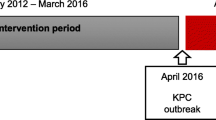Abstract
Antibiotic use in intensive care units (ICUs) can promote antimicrobial resistance. Outbreaks of multi-resistant bacteria significantly affect patient outcomes and delivery of care. Antibiotic stewardship programmes (ASPs), combining root-cause analyses and multi-faceted prevention strategies, are necessary, often at significant cost and time. Which elements of such strategies have the largest impact on antibiotic usage following an outbreak is unclear. The aim of this study was to investigate how antibiotic usage in a university hospital ICU changed with a non-protocolised ASP following a disruptive outbreak of multi-resistant Acinetobacter baumannii (MRAB). This was a three time-period observational cohort study. The primary endpoint was the change in overall antibiotic usage (daily defined dose, DDD, antibiotic-days, antibiotic-courses) for consecutive ICU patients staying >48 h, over three 6-month study time periods pre-MRAB (2008, n = 84) and post-MRAB (2010, n = 88; 2012, n = 122). Secondary endpoints were changes in antibiotic usage and patient demographics, in predefined admission categories (Medical Emergency, ME; Surgical Elective, SEL; and Surgical Emergency, SE). The mean age (54.6 ± 17.7, 58.1 ± 17.9, 62.8 ± 19.1 years*) and severity of illness (APACHE 14.8 ± 8.0, 16.7 ± 6.8, 18.3 ± 6.1*) increased, particularly medical admissions. There was a sustained reduction in DDD antibiotic usage [1895.1 (2008), 1224.2 (2010), 1236.6 (2012) per 1000 patient-days] but no overall change in antibiotic-days or antibiotic-courses. Antibiotic usage (antibiotic-days) fell significantly in surgical emergency admissions [20.2 ± 32.1, 4.6 ± 7.4*, 5.9 ± 7.3]. There was a sustained drop in beta-lactam, quinolone, glycopeptide and macrolide usage. Following an MRAB outbreak, and subsequent operational changes including enhanced ASPs (non-protocolised), there was a sustained overall fall in antibiotic usage in spite of an increase in disease severity over 5 years.

Similar content being viewed by others
References
World Health Organization (WHO) (2014) Antimicrobial resistance: global report on surveillance: 2014 summary. Available online at: http://www.who.int/iris/bitstream/10665/112642/1/9789241564748_eng.pdf
Brusselaers N, Vogelaers D, Blot S (2011) The rising problem of antimicrobial resistance in the intensive care unit. Ann Intensive Care 1:47. doi:10.1186/2110-5820-1-47
Hanberger H, Arman D, Gill H, Jindrák V, Kalenic S, Kurcz A, Licker M, Naaber P, Scicluna EA, Vanis V, Walther SM (2009) Surveillance of microbial resistance in European intensive care units: a first report from the Care-ICU programme for improved infection control. Intensive Care Med 35(1):91–100. doi:10.1007/s00134-008-1237-y
Chandrasiri P, Elwitigala JP, Nanayakkara G, Chandrasiri S, Patabendige G, Karunanayaka L, Perera J, Somaratne P, Jayathilleke K (2013) A multi centre laboratory study of Gram negative bacterial blood stream infections in Sri Lanka. Ceylon Med J 58(2):56–61. doi:10.4038/cmj.v58i2.5680
Meyer E, Gastmeier P, Deja M, Schwab F (2013) Antibiotic consumption and resistance: data from Europe and Germany. Int J Med Microbiol 303(6–7):388–395. doi:10.1016/j.ijmm.2013.04.004
McKinnell JA, Miller LG, Eells SJ, Cui E, Huang SS (2013) A systematic literature review and meta-analysis of factors associated with methicillin-resistant Staphylococcus aureus colonization at time of hospital or intensive care unit admission. Infect Control Hosp Epidemiol 34(10):1077–1086. doi:10.1086/673157
Dellinger RP, Levy MM, Rhodes A, Annane D, Gerlach H, Opal SM, Sevransky JE, Sprung CL, Douglas IS, Jaeschke R, Osborn TM, Nunnally ME, Townsend SR, Reinhart K, Kleinpell RM, Angus DC, Deutschman CS, Machado FR, Rubenfeld GD, Webb S, Beale RJ, Vincent JL, Moreno R; Surviving Sepsis Campaign Guidelines Committee including The Pediatric Subgroup (2013) Surviving Sepsis Campaign: international guidelines for management of severe sepsis and septic shock, 2012. Intensive Care Med 39(2):165–228. doi:10.1007/s00134-012-2769-8
Lee HY, Chen CL, Wu SR, Huang CW, Chiu CH (2014) Risk factors and outcome analysis of acinetobacter baumannii complex bacteremia in critical patients. Crit Care Med 42(5):1081–1088. doi:10.1097/CCM.0000000000000125
Levy MM, Fink MP, Marshall JC, Abraham E, Angus D, Cook D, Cohen J, Opal SM, Vincent JL, Ramsay G; SCCM/ESICM/ACCP/ATS/SIS (2003) 2001 SCCM/ESICM/ACCP/ATS/SIS International Sepsis Definitions Conference. Crit Care Med 31(4):1250–1256
Cahill OJ, Claro T, O’Connor N, Cafolla AA, Stevens NT, Daniels S, Humphreys H (2014) Cold air plasma to decontaminate inanimate surfaces of the hospital environment. Appl Environ Microbiol 80(6):2004–2010. doi:10.1128/AEM.03480-13
Zhang YZ, Singh S (2015) Antibiotic stewardship programmes in intensive care units: why, how, and where are they leading us. World J Crit Care Med 4(1):13–28
Assink-de Jong E, de Lange DW, van Oers JA, Nijsten MW, Twisk JW, Beishuizen A (2013) Stop Antibiotics on guidance of Procalcitonin Study (SAPS): a randomised prospective multicenter investigator-initiated trial to analyse whether daily measurements of procalcitonin versus a standard-of-care approach can safely shorten antibiotic duration in intensive care unit patients—calculated sample size: 1816 patients. BMC Infect Dis 13:178. doi:10.1186/1471-2334-13-178
Acknowledgements
We wish to thank the patients and staff of the Intensive Care Unit, Chelsea and Westminster Hospital, who have contributed to the data involved in this study.
Conflict of interest
The authors declare that they have no conflict of interest.
Author information
Authors and Affiliations
Corresponding author
Rights and permissions
About this article
Cite this article
Singh, S., Zhang, Y.Z., Chalkley, S. et al. A three-point time series study of antibiotic usage on an intensive care unit, following an antibiotic stewardship programme, after an outbreak of multi-resistant Acinetobacter baumannii . Eur J Clin Microbiol Infect Dis 34, 1893–1900 (2015). https://doi.org/10.1007/s10096-015-2429-3
Received:
Accepted:
Published:
Issue Date:
DOI: https://doi.org/10.1007/s10096-015-2429-3




